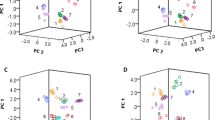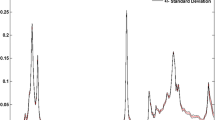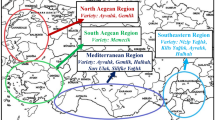Abstract
This work presents a method for an efficient differentiation of olive oil and several types of vegetable oils using chemometric tools. Triacylglycerides (TAGs) profiles of 126 samples of different categories and varieties of olive oils, and types of edible oils, including corn, sunflower, peanut, soybean, rapeseed, canola, seed, sesame, grape seed, and some mixed oils, have been analyzed. High-performance liquid chromatography coupled to a charged aerosol detector was used to characterize TAGs. The complete chromatograms were evaluated by PCA, PLS-DA, and MCR in combination with suitable preprocessing. The chromatographic data show two clusters; one for olive oil samples and another for the non-olive oils. Commercial oil blends are located between the groups, depending on the concentration of olive oil in the sample. As a result, a good classification among olive oils and non-olive oils and a chemical justification of such classification was achieved.

PCA scores plot of oil samples. Olive oils (asterisk), non-olive oils (filled square) and oil blends (filled inverse triangle)








Similar content being viewed by others
References
COI/T.15/NC No 3/Rev. 4 (2009) Trade standard applying to olive oils and olive-pomace oils. International Olive Council, Madrid
International Olive Oil Council, Olive Oils (1997) Table 1: Production http://www.internationaloliveoil.org/downloads/production2_ang.PDF, nov 2009AOCS Official Method Ce 5b-89. American Oil Chemists’ Society, S. Boulder
Commission Regulation (EEC) No 1989/2003 amending Regulation (EEC) No 2568/91 on the characteristics of olive oil and olive-pomace oil and on relevant methods of analysis. Off J Eur Commun L295/57
AMS-FV-08-0073-0006 (2010) United States standards for grades of olive oil and olive-pomace oil. US Department of Agriculture, Washington
COI/T.20/Doc. No 20/Rev. 2 (2008). Method of analysis. Difference between actual and theoretical content of triacylglycerols with ECN 42. International Olive Council, Madrid
AOCS Official Method Ce 5b-89 (1997). American Oil Chemists’ Society, S. Boulder
Cristopoulou E, Lzaraki M, Komaitis M, Kaselimis K (2004) Food Chem 84:463–474
Piravi-Vanak Z, Ghavami M, Ezzatpanah H, Arab J, Safafar H, Ghasemi JB (2009) J Am Oil Chem Soc 86:827–833
Aparicio R, Aparicio-Ruíz R (2000) J Chromatogr A 881:93–104
Dourtoglou VG, Dourtoglou T, Antonopoulos A, Stefanou E, Lalas S, Poulos C (2003) J AOC Int 80:203–208
Park JR, Lee DS (2003) Bull Korean Chem Soc 24:527–530
Ollivier D, Artaud J, Pinatel C, Durbec JP, Guérère M (2003) J Agric Food Chem 51:5723–5731
Ollivier D, Artaud J, Pinatel C, Durbec JP, Guérère M (2006) Food Chem 97:382–393
Savorani F, Tomasi G, Engelsen SB (2010) J Magn Reson 202:190–202
Wise BM, Gallagher NB, Bro R, Shaver JM, Windig W, Koch RS (2006) PLS_Toolbox 4.0 Manual for use with MATLABTM, Eigenvector Research, Inc. Wenatchee
Jaumot J, Gargallo R, de Juan A, Tauler R (2005) Chemom Intell Lab Syst 76:101–110
Amigo JM, Skov T, Bro R (2010) ChroMATHography: solving chromatographic issues with mathematical models and intuitive graphics. Chem Rev. doi:10.1021/cr900394n
Acknowledgments
The authors acknowledge the Andalusia Regional Government (Consejería de Innovación, Ciencia y Empresa, project P07-FQM-02667) for financial assistance. This work has also been partially supported by European Regional Development Funds. In addition, one of the authors, PME, acknowledges the postgraduate grant to the Consejo Nacional de Ciencia y Tecnología, México (CONACYT).
Author information
Authors and Affiliations
Corresponding author
Additional information
Published in the special issue Chemometrics (VII Colloquium Chemiometricum Mediterraneum) with Guest Editors Marcelo Blanco, Juan M. Bosque-Sendra, and Luis Cuadros-Rodríguez.
Rights and permissions
About this article
Cite this article
de la Mata-Espinosa, P., Bosque-Sendra, J.M., Bro, R. et al. Discriminating olive and non-olive oils using HPLC-CAD and chemometrics. Anal Bioanal Chem 399, 2083–2092 (2011). https://doi.org/10.1007/s00216-010-4366-4
Received:
Revised:
Accepted:
Published:
Issue Date:
DOI: https://doi.org/10.1007/s00216-010-4366-4




